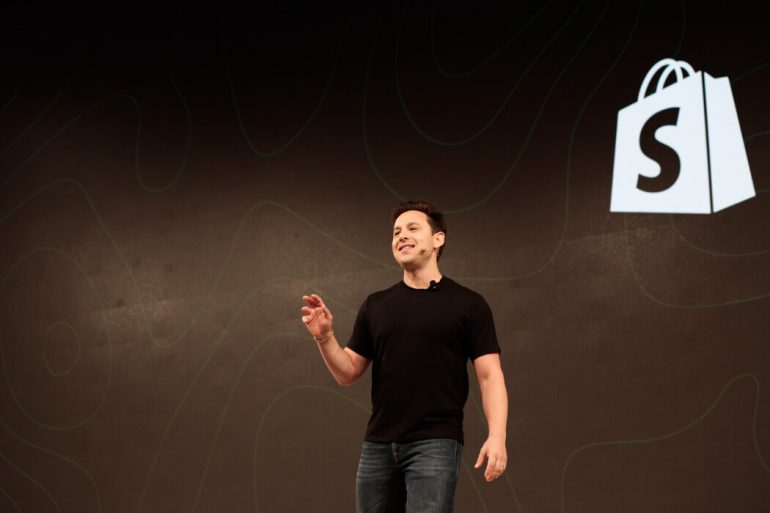Ryan Petrimoulx is BetaKit’s e-commerce expert. We sent him to Shopify Unite to report back with his thoughts on the biggest announcements from Canada’s retail juggernaut.
Unite is Shopify’s annual conference for partners and developers of the platform to announce new updates from the company, some of which will be rolled out and available immediately, with others being estimated for later in the year.
The three-day conference recently celebrated its first year at the Beanfield Centre, growing in size from previous years, attracting over 1,300 global attendees from places such as the United Kingdom and New Zealand. The event included workshops and product demos, but the keynote on all the new product announcements was the focal point.
Shopify Fulfillment Network: the 3PL for all
The most impactful rollout of the keynote was Craig Miller, Shopify’s chief product officer, announcing the launch of the Shopify Fulfillment Network, a US-based solution for qualifying US merchants that will allow for a ‘white-glove’ third-party logistics (3PL) service.
Defined as a “geographically dispersed network of fulfillment centers with smart inventory-allocation technology, powered by machine learning,” the service is meant to predict the closest fulfillment centers and optimal inventory quantities to ensure fast, low-cost delivery. Shopify has set the benchmark of achieving same-day fulfillment, with a two-day delivery window and 99.9 percent order accuracy.

In my opinion, this new offering represents a change in the overall landscape of e-commerce. Until this point, the only accessible options that merchants had available to them was dealing with 3PL companies or, and this is the big one, Amazon. The e-commerce giant’s Fulfilled by Amazon (FBA) service is a requirement for merchants to be eligible for Amazon Prime listings, the one to two-day shipping option offered to Amazon customers by subscription.
“Once enabled, the merchant never has to worry about shipping again,” was the bold statement made by Shopify’s Miller during his announcement regarding the launch of service, which is seemingly designed to directly challenge the global Amazon FBA network.
It is the global nature of the FBA network that resulted in Amazon being the target of a 2018 investigation by the EU Competition Commissioner. It was alleged to have unfairly copied popular products sold through its platform, to be sold under one of the company’s 120 private label brands, according to reporting by Bloomberg.
Based on that controversy and the “mafia-like” operations of the FBA network, this offering by Shopify has significant implications for leveling the playing field by providing a solution to something that is the bane of every level e-commerce merchant.
The AR/VR game changer
If we turn the clock back to 2012, when large online retailers such as Zappos were touting the “miraculous” impact of product page videos on their conversion rate, we can derive a working retail theorem: e-commerce customers will always respond better with more information about the product they want to purchase.
Snapping back to 2019, Shopify is rolling out the next-gen version of this type of feature with the introduction of AR/VR capabilities incorporated into product pages.
Shopify’s product launch originally hit the scene in October 2018 when the company partnered with CGTrader, one of the leading 3D model marketplaces.

”This year we decided to make it more available, more readily available to merchants to simply upload it by drag-and-drop,” Cynthia Savard Saucier, director of UX and channels at Shopify said at this year’s event. “Last year we announced this and this year we’re making this OOTB.”
“Immersive shopping experiences are the future of eCommerce,” she stated, citing data points indicating that a customer who has interacted with a 3D model of a product is more than twice as likely to complete a purchase.
For merchants selling physical goods, reportedly 93 percent of Shopify’s user base, the desire to replicate the touch-and-feel experience present in brick-and-mortar retail is significant. The widespread roll-out of this functionality across the Shopify platform offers opportunities for both merchant network and partner ecosystem alike.
In conversation with Saucier, she noted that the process to achieve 3D currently includes working with the two Shopify partners who are at the tip of the spear in terms of the integration of the functionality. By providing said partner with those products to create 3D models of the items, the merchant will then be able to upload that file format into their store. The Shopify platform will then convert the files into a format that can be manipulated by the customer to get a fulsome view of the product they are looking to purchase.
As attractive as this option could be for merchants, the question of implementation cost seems to be a nebulous one. When asked, Saucier’s response was that there would obviously be added cost to leverage this opportunity, “it really depends on a lot of different things but we’re not talking $20k either.”
Dark mode strikes again with the updated Shopify POS
A few years ago, if you looked at a tablet-based retail POS, you’d notice they all had the same appearance. A grid of product photos with truncated product names; functional but not necessarily intuitive. If you had a medium-to-large catalogue of products, you had to hope the search functionality was working up to snuff.
That’s the first change you notice about the new Shopify POS, aside from that dark mode vibe: the relatively useless product grid is gone, replaced with a customizable display that’s useful instead of a UX mulligan.

It would make sense that Shopify would drive for relaunching its POS, as the company is clocking 100,000 merchants per year via the POS solution. Upgrading the home screen to a customizable Smart Gird really makes life easier for merchants and keeps the partner ecosystem in mind.
“I think that apps in POS finally have a first-class experience,” Arpan Podduturi, director of product at Shopify said. “If you look at the stuff that we did on the POS cart app extension, there’s a lot of stateless updating that happens in the experience. Those are things we can bring over to POS next and you’ll be able to see those types of actions happen on the smart grid.”
Hands up if you remember when the term ‘omni-channel’ was that elusive ring all the retailers were reaching for and attempting to understand. This POS upgrade takes giant leaps towards making that promise accessible to the retail industry.
Having launched Shopify POS in 2013, the company has grown its product to match POS competitors such as Vend and Lightspeed, which recently IPO’d. While Shopify’s POS gave the company an advantage in the e-commerce space, its initial POS offering did well but definitely had some critics in the retail community, particularly those who had multiple physical locations. The inability to manage your global inventory was a deal-breaker.
Shopify addressed this issue by rolling out multi-location support and saw a big uptick.
“Once locations rolled out, we saw our merchants say that they could open more stores, ‘now I can grow’,” said Podduturi. “For us, that meant the experience wasn’t really built for them and it wasn’t meeting their needs as they were growing. We said, ‘how do we create an experience that works for them but doesn’t leave the more casual retailer behind?’ We’ve been working really hard at creating an experience that has layers.”
There were a number of other announcements from Unite 2019, but these three product updates and services seem like game changers for both Shopify and its partners. It’s almost as though the company has gone from selling snowboards to setting its sights on the entire mountain, from the bunny hill to the top of the chairlift.
Images courtesy Shopify.


